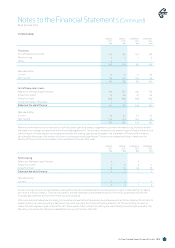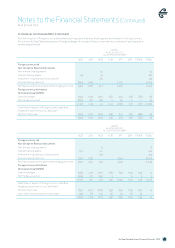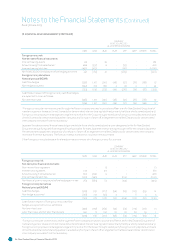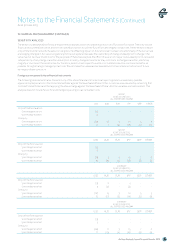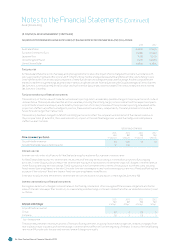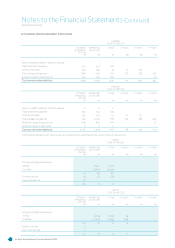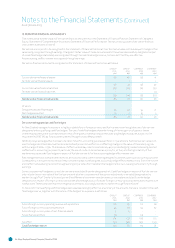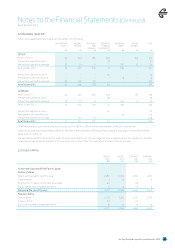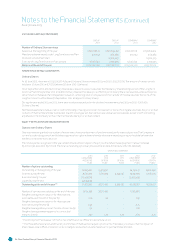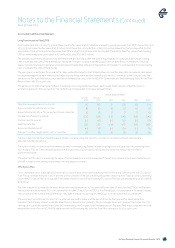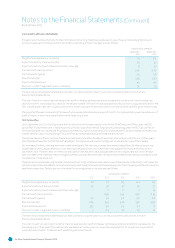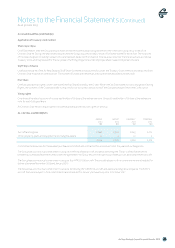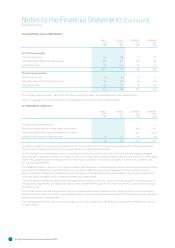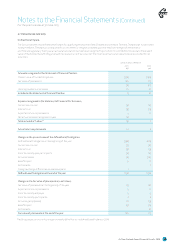Air New Zealand 2013 Annual Report Download - page 39
Download and view the complete annual report
Please find page 39 of the 2013 Air New Zealand annual report below. You can navigate through the pages in the report by either clicking on the pages listed below, or by using the keyword search tool below to find specific information within the annual report.
Air New Zealand Annual Financial Results 37
. DERIVATIVE FINANCIAL INSTRUMENTS CONTINUED
Foreign currency hedges
The Group hedge accounts the foreign currency risk arising on future foreign currency operating revenue, operating expense and capital
expenditure transactions.
Forward points are excluded from the hedge designation in respect of operating revenue and expenditure transactions and are marked
to market through earnings. Forward point costs of $23 million in respect of these derivatives were marked to market through “Finance
costs” in the year to 30 June 2013 (30 June 2012: $29 million of costs).
Accounting ineffectiveness arising in the year to 30 June 2013 on these cash flow hedges was nil on both operating and capital
transactions (30 June 2012: Nil on both operating and capital transactions).
A proportion of United States Dollar denominated borrowings are designated as the hedging instrument in qualifying cash flow hedges
of highly probable future foreign currency sales of non-financial assets. This reduces the level of derivative cover required to offset the
foreign currency risk arising on foreign currency borrowings and lease obligations. No accounting ineffectiveness arises on these hedge
relationships.
Fuel hedges
Where the Group uses crude oil options or collar options to hedge price risk in jet fuel, the intrinsic value component of these derivatives is
designated as a cash flow hedge. All other components (mainly time value) are marked to market through earnings, with gains of $1 million
recognised within “Fuel” in the year to 30 June 2013 (30 June 2012: $5 million gain).
Accounting ineffectiveness arising in the year to 30 June 2013 of $7 million loss was recognised within “Fuel” (30 June 2012: $12 million gain).
NON-HEDGE ACCOUNTED DERIVATIVES
Foreign currency derivatives
Where changes in the fair value of a derivative provide a natural offset to the underlying hedged item as it impacts earnings, hedge
accounting is not applied. Both the changes in value of the hedged item and the hedging instrument are recognised through the same line
within the Statement of Financial Performance.
Foreign currency translation gains or losses on lease return provisions and non-hedge accounted United States Dollar denominated
interest-bearing liabilities are recognised in the Statement of Financial Performance within “Foreign exchange gains/(losses)”. Marked
to market gains or losses on non-hedge accounted foreign currency derivatives provide a natural offset to these foreign exchange
movements, and are also recognised within “Foreign exchange gains/(losses)”.
During the year to 30 June 2013, a gain of $8 million was recognised in respect of the above non-hedge accounted foreign currency
derivatives (30 June 2012: $30 million gain), which was offset by exchange movements on the underlying exposures. Forward point costs
of $17 million in respect of these derivatives were marked to market through “Finance costs” in the year to 30 June 2013 (30 June 2012: $19
million of costs).
Fuel derivatives
Short-dated fuel derivatives are not hedge accounted due to the short term nature of these instruments, and are marked to market
through earnings. In the year to 30 June 2013, nil was recognised within “Fuel” (30 June 2012: Nil).
Equity swaps
During the year to 30 June 2013, Air New Zealand entered into an equity derivative representing an additional interest of 3% of shares
in Virgin Australia Holdings Limited (Virgin Australia). The derivative is a share forward transaction which carries no voting rights. The
prepaid amount has been recognised within current “Other assets” in the Statement of Financial Position. The derivative was marked to
market during the year with a loss of $5 million having been recognised in “Other expenses” in the Statement of Financial Performance.
In the year ended 30 June 2012, Air New Zealand entered into equity derivatives whereby the Group was guaranteed a minimum additional
exposure of 3.5% interest in Virgin Australia and up to a maximum additional exposure of 5% interest. Air New Zealand exercised the
derivatives over the 3.5% interest during the year ended 30 June 2012, and the 1.5% interest during the year ended 30 June 2013. Derivative
gains of $2 million were recognised during the year ended 30 June 2013 (30 June 2012: $10 million gain). The exercise of the derivatives in the
year ended 30 June 2012 yielded a $13 million gain, which, together with unrealised gains recognised in respect of the remaining derivatives
offset by option costs, lead to a net gain of $10 million. The gain/(loss) in respect of these equity derivatives is included in the “Non-hedge
accounted derivatives” line in Note 3 and in “Other expenses” in the Statement of Financial Performance.
Notes to the Financial Statements (Continued)
As at 30 June 2013


